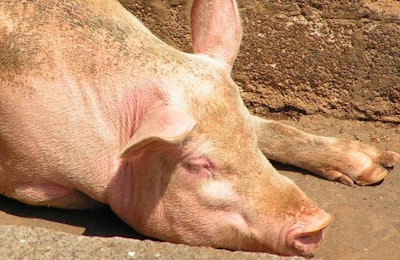
Consumption of pork has been growing in Uruguay in recent years, with much of the increased demand satisfied by imports.
Continuing a recent trend, pig numbers declined in 2014, according to the Yearbook of the Office of Agricultural Planning and Policy 2015 (Opypa) of the Ministry of Livestock, Agriculture and Fisheries. Stocks in 2006 to 2008 averaged around 240,000 but fell sharply in 2009. They recovered the following year, reaching a peak of 225,000 in 2011 and stood at 210,000 in 2013, the last year for which the statistics are reported.
Pig meat production peaked in 2007 at a little over 21,000 metric tons (mt) but output has since remained fairly steady at between 18,000 and 19,000mt. In 2014, 78 percent of animals are slaughtered in approved establishments, an increase of around 10 percent over the decade. Of the 17 pig meat slaughter companies, just two – Mirnabel S.A. and Ardistar S.A. – account of 81 percent of the market. Three-quarters of the pigs are slaughtered in the southern states of Canelones, San Jose and Florida.
Almost all the pork produced is consumed in Uruguay. Exports in 2014 amounted to just 38 mt, down from 695 mt in 2006.
Pork consumption has been growing over the last decade, according to Opypa. With domestic production stagnant, imported volume has been increasing over recent years – rising steadily from 9,475 mt in 2008 to 26,277 mt in 2014. At 22,325 mt for the first 10 months of the year, a further increase looks likely for 2015.
Brazil is the leading supplier of pork to Uruguay, accounting 97 percent of the total in 2007 although this had fallen to 83 percent by 2014. European exporters have taken an increasing share in recent years, with Spain and Belgium accounting for 14 percent and 8 percent, respectively, of imports in the period January-October 2015. The report indicates that, since 2008, the domestic market has been unable to fulfill increasing demand because of the strong price competitiveness of imported products. Imports now account for 64 percent of the pork consumed in Uruguay; in 2006, the figure was 35 percent.
Per-capita consumption of pork increased 54 percent between 2009 and 2014 to reach 14.9 kilograms per year. Pig meat now accounts for 15 percent of total meat consumption in Uruguay (98.6 kg).
There is no information on prices of all pork cuts in the domestic market but those of pork chops are recorded and generally, they follow the same trend as for beef. However, in July of 2015, the average price of the pork chop increased 8.8 percent over the month and then fell by some 2 percent to 3 percent over the following two months.These changes were the result of government changes to Value Added Tax (VAT)on cuts of pork from July 2015.In 2007, VAT of 10 percent was lifted on pork cuts with bone in a move that was renewed every 3 to 6 months until July of 2015.
According to the report, the rise in popularity of pig meat in Uruguay is unlikely to be reversed in the short term. While falling feed grain prices there are easing the situation for domestic pork producers, the same applies to those in exporting countries, particularly Brazil, where the falling value of the real increases the competitiveness of that country still further. Government policies are urgently needed to integrate and support the country’s own pig meat supply chain, the report’s authors add.

















